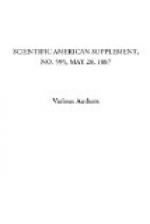[Illustration: Fig. 1.—Tent or table fan or punka.]
Looking around you, you find the punka immovable. The bahi still holds the cord that pulls it, but it is because he has tied it to his hand. He has gently slid to the floor in a squatting posture. He is asleep and you are burning. A vigorous exclamation brings him to his feet all standing, and he begins to pull the punka with all his might, and you have a feeling of ease and coolness. It is like the passage from an attack of fever to a state of comfort in an intermittent disease. So the punka is seen everywhere—in the temple and court room and other public places, as well as in private dwellings. It is one of the first things to astonish the European upon his arrival in India, and it is not long before he has to bless the happy invention.
Although, in a country where the temperature generally reaches, and even often exceeds, 40 deg. C., it is absolutely necessary to obtain by every means possible a factitious coolness without which the Indies would not be habitable for Europeans; and although there is no hesitancy in putting up these punkas everywhere to be maneuvered by bahis, the elevation of the temperature is not such in France that we are obliged to have recourse to such processes. But, without being forced thereto by nature, it is none the less true that we are often the more incommoded by heat in that we are not accustomed to it, and that in southern France, at certain hours of the day, such heat becomes absolutely unbearable. We can, it is true, obtain a little air by moving a fan, but, aside from the fact that this exercise soon becomes tiresome, it prevents the use of the hand that is fanning.
[Illustration: Fig 2.—An apartment fan.]
The new apparatus which have just been devised by Mr. G. Bozerian permit of one’s fanning himself all day long if he wants to, without any fatigue, and while he is eating, reading, writing, etc.
In one of these apparatus, designed to be used in the open air (Fig. 1), we find a table, a tent, and a fan combined; but as each part is independent, we can have the table and fan without tent, or the fan and pedals alone without table or tent. Under the tent there is arranged a frame which pivots freely in apertures formed in the uprights that support both the tent and table. This frame is connected, through two levers, with the pedals upon which one’s feet rest. The motion of the pedals is an alternating one like those of sewing machines; but while in the case of the latter a pressure has to be exerted that soon becomes very tiresome, the motion in Mr. Bozerian’s apparatus is so easy that it is only necessary to raise the toes of each foot in succession in order to produce a swing of the fan through the weight alone of the foot that is pressing. The frame, which when at rest hangs perpendicularly, describes about a quarter of a circle when the extremity of the foot is raised about an inch. In consequence of the absence of passive resistances, motion occurs without any stress, and almost mechanically, giving air not only to him who is actuating the fan, but also to his vis-a-vis.




